Topics
Category
Era
Lacemaking at Birch Coulee, 1893–1926
Dakota lace makers from Birch Coulee, including Maggie Whipple, display their work at a photography studio in Morton, Minnesota, ca. 1900. Collection III.40.101, Minnesota Historical Society.
The lace-making school that operated at Birch Coulee at the turn of the twentieth century is an important part of the history of the Lower Sioux Indian Community. Although the school was an extension of the assimilation efforts directed towards Dakota people in the late 1800s, the Birch Coulee lace makers used the project to support their community, and to continue a long tradition of communal artmaking among Dakota women.
Before the US government named and recognized the Lower Sioux Indian Community in 1938, the same area was known as Birch Coulee. Its Dakota name was, and is, Caŋṡayapi (Where They Paint the Trees Red). In the early 1890s, Dakota women living there learned that their Ojibwe neighbors across Minnesota—at White Earth, Red Lake, and Leech Lake—were earning money by making lace as part of the Sybil Carter Indian Lace Association. Eager to bring the same financial support to Birch Coulee, the women contacted Carter and asked her to organize a similar operation for them. Carter agreed. With the help of Bishop Henry Whipple, they organized a lace-making school at Birch Coulee in 1893 and opened it inside the local mission. It was the only such school in Minnesota with Dakota students.
Carter and other teachers introduced Birch Coulee students to the process of making lace, gave them supplies to begin working, and paid them by the piece. They mailed the finished lacework items to colleagues in New York, who then sold them in a shop on Fourth Avenue. In its first year of operation alone, the shop sold the lace to some of the most socially prominent women in the city, including Anne Morgan, Edith Stuyvesant Vanderbilt, and Olivia Mayard Cutting.
In October of 1895, only two years after the school opened, Birch Coulee students traveled by train to Fort Snelling to exhibit their lace at the Women’s Auxiliary Missionary Society in Minneapolis. Almeda (Amelia) St. Clair led the group, accompanied by elders and young women. In a dispatch filed after the event, the St. Paul Daily Globe praised “the dexterous manner in which they ply their trade.”
Almeda St. Clair, Julia Lawrence, Amelia Salisbury, and other women from Birch Coulee exhibited their artistry at the Paris Exposition (1900), the Pan-American Exposition (1901), and the Louisiana Purchase Exposition (1904). After the Paris Exposition of 1900, the Indianapolis Sunday Journal noted that “The most elaborate lace and the most intricate patterns are made at Birch Coulie [sic], and the work shown at the Paris exposition was principally from this mission.” Jeanette Brooks Campbell, Maggie Whipple, Mary Wabasha, Lucy Thomas, Julia Jones, Julia Lawrence, and Hanna Wells also participated in the school during this period.
Unlike Ojibwe lace makers in Minnesota, who made needlepoint lace, most Birch Coulee lace makers made bobbin lace, also called pillow lace. They made a variety of products for sale, including piano scarves, lampshades, and altar cloths. The St. Paul Globe reported in 1903 that one lace bedspread made by a Birch Coulee artist had sold for $500. It also claimed that the lacework from Minnesota was “classed with the best Native lace in the country.”
The lace-making schools at Birch Coulee and in other Minnesota reservations served an assimilating and Christianizing agenda that cast Native women as primitive. As an Episcopal Deaconess and missionary, Carter used the project to promote Christianity, “cleanliness,” and industry among Native women, in line with the US government's overall policies. The exploitation underlying the project made Sybil Carter wealthy while leaving relatively little money for the lace makers themselves. Although Carter did promote artistry in the form of lace, she prevented women at Birch Coulee from continuing the traditional Dakota arts of beadwork, quillwork, and pottery.
In spite of Carter’s paternalism, the creation and success of the school itself show the community’s agency over its own affairs. Lace-makers used their training to build economic self-sufficiency while maintaining their Dakota identity. Some, like those who presented to the Women’s Auxiliary Missionary Society in 1895, seized the opportunities provided by lace-making to travel and exhibit their work. They used the school as a site of community gathering, a place of education, and a source of employment. One writer noted in 1900 that the Birch Coulee women “take up the art with a strenuous desire to help themselves and their people.”
After 1910, there is little evidence of lacemaking at Birch Coulee, and the Sybil Carter Lace Association disbanded in 1926. Dakota women, however, continued to make art with traditional materials like beads, ribbons, quills, and hides. At the same time, they invented handicrafts in hybrid styles (miniature moccasins, beaded prayer-book covers) to sell to tourists. In this way, they built on Dakota traditions while continuing to provide the income that had helped their community during the lacemaking years.
Bibliography
Chase, Michelle C. “American Lace.” MA thesis, Winthrop University, 2004.
“Cleanliness and Work.” Semi-Weekly New Era (Lancaster, PA), March 21, 1900.
Duncan, Kate C. “American Indian Lace Making.” American Indian Art 5, no. 3 (Summer 1980): 28–35.
Dwyer, Mary. “Sybil Carter’s Legacy: Native American Lace.” PieceWork (November/December 1993): 66–71.
Guthrie, Jane W. “Lace-Making Among the Indians.” Outlook (September 1, 1900) 59–62.
Hutchinson, Elizabeth West. “Progressive Primitivism: Race, Gender and Turn-of-the-Century American Art.” PhD diss., Stanford University, 1998.
“Indian Lace Makers: A Dozen of Them Visit the Twin Cities.” St. Paul Daily Globe, October 4, 1895.
“Indian Lace Makers: Miss Sybil Carter’s Practical Work Among Indian Women.” Sunday Journal (Indianapolis, IN), October 14, 1900.
“Indian Lace Making.” St. Paul Globe, August 16, 1894.
“Indian Lace-Makers.” Evening Star (Washington, DC), February 28, 1903.
“Indian Women’s Needlework.” St. Paul Globe, December 20, 1903.
Lincoln, Louise, and Paulette Fairbanks Molin. “Unanswered Questions: Native Americans and Euro-Americans in Minnesota.” In Art and Life on the Upper Mississippi, 1890-1915, edited by Michael Conforti (Newark: University of Delaware Press), 299–322.
“Making Lace By Indian Women.” Boston Evening Transcript, March 21, 1896.
Snodgrass, Mary Ellen. Frontier Women and Their Art: A Chronological Encyclopedia. Lanham, MD: Rowman & Littlefield, 2018.
Sibyl Carter Indian Mission and Lace Industry Association annual report, 1905–1906.
https://archive.org/details/annualreport00sybi/page/6/mode/2up
Trump, Erik Krenzen. “The Indian Industries League and Its Support of American Indian Arts, 1893–1922: A Case Study of Changing Attitudes Toward Indian Women and Assimilationist Policy.” PhD diss., Boston University, 1996.
Related Resources
Secondary
Hyman, Collette. Dakota Women’s Work: Creativity, Culture, & Exile. St. Paul: Minnesota Historical Society Press, 2012.
Web
Lower Sioux Indian Community.
https://lowersioux.com
Related Images
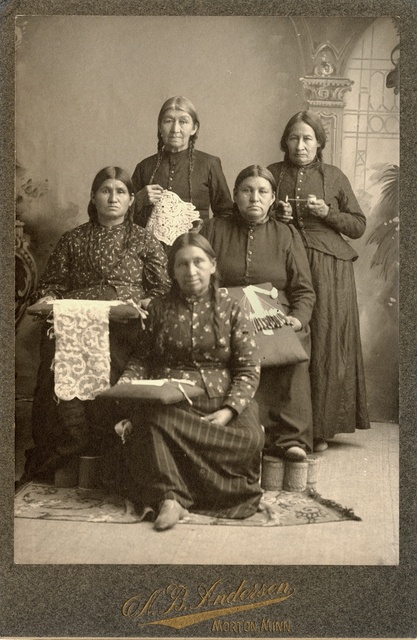
Dakota lace makers, including Maggie Whipple
Dakota lace makers from Birch Coulee, including Maggie Whipple, display their work at a photography studio in Morton, Minnesota, ca. 1900. Collection III.40.101, Minnesota Historical Society.
Holding Location
More Information
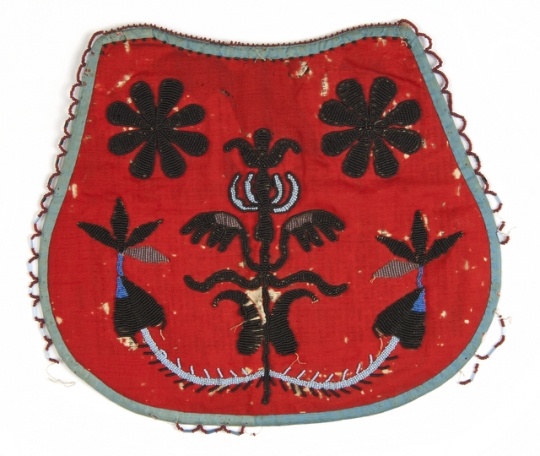
Dakota beaded bag
Beaded bag made by Margeurite Metivier (Dakota), ca.1860.
All rights reserved
Holding Location
More Information
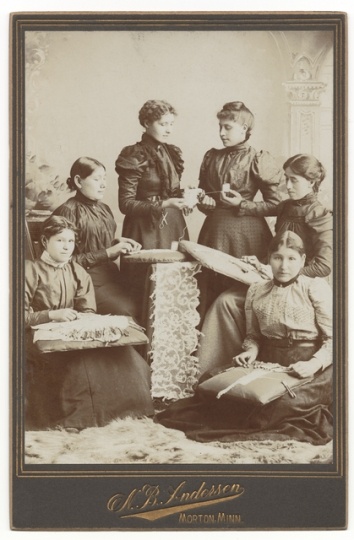
Dakota lace makers in Morton
Dakota lace makers display their work at a photography studio in Morton, Minnesota (Birch Coulee), ca. 1900. Pictured are (left to right): Mary Wabasha, Lucy Thomas, Amelia St. Clair, Julia Jones, Julia Lawrence, and Hanna Wells. Collection III.40.102, Minnesota Historical Society.
Holding Location
More Information
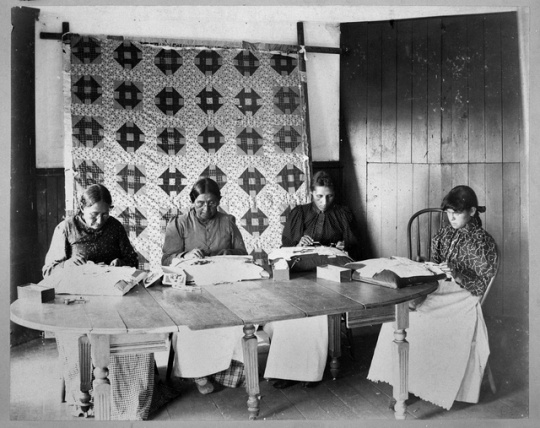
Dakota lace makers at the Redwood Mission (Birch Coulee)
Dakota lace makers at the Redwood Mission (Birch Coulee), Morton, 1897.
Public domain
Holding Location
More Information
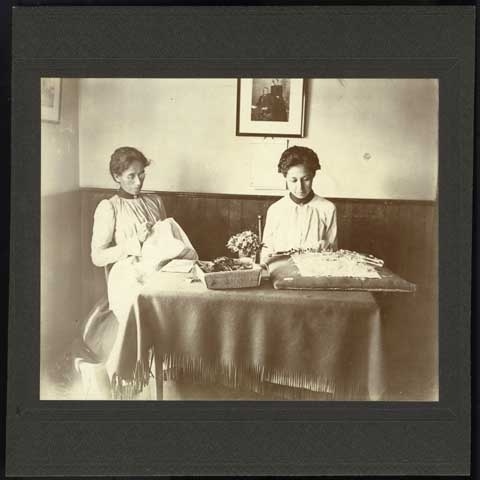
Emma Good Thunder and Jeanette Crooks
Emma Good Thunder (left) and Jeanette Crooks (right) working on needlework and bobbin lace, respectively, at the Redwood Agency (Birch Coulee), ca. 1900.
Holding Location
More Information
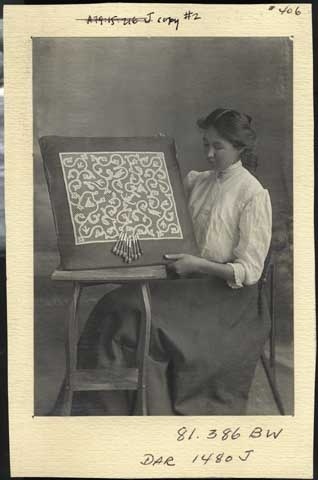
Janette (Jeannette) Crooks displaying Battenberg lace piece
Janette (Jeannette) Crooks displaying Battenberg lace piece, c. 1900.
Public domain
Holding Location
More Information
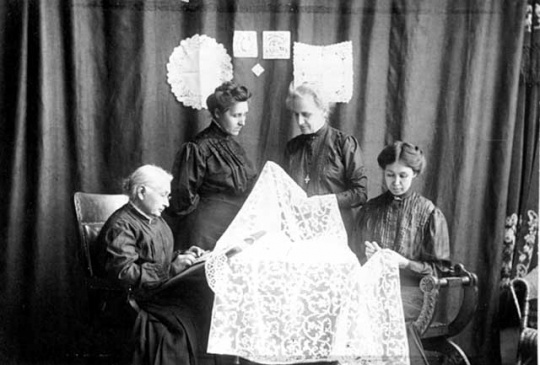
Mrs. Hibbard, Almeda St. Clair, Susan Salisbury, and Jeanette Crooks Campbell
Mrs. Hibbard, Almeda St. Clair, Susan Salisbury, and Jeanette Crooks Campbell display lace made at the Redwood Mission (Birch Coulee), ca. 1900. Not available in Collections Online; photograph N4.4 r40, Minnesota Historical Society.
Holding Location
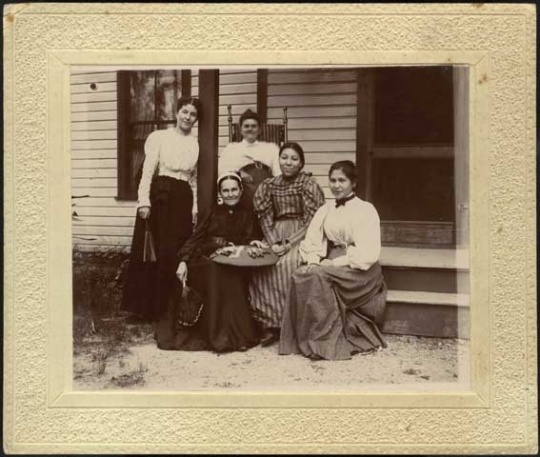
Dakota lace makers with Sybil Carter
Dakota lace makers with Sybil Carter, ca. 1905.
Holding Location
More Information
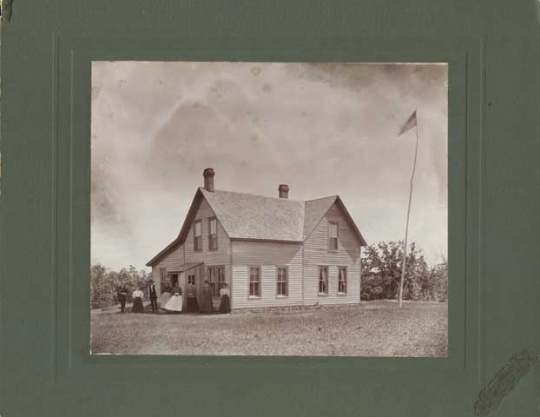
Dakota mission at Morton (Birch Coulee)
The Dakota mission at Morton (Birch Coulee), ca. 1900. The Sybil Carter Indian Lace Association operated a school on the site beginning in 1893.
Holding Location
More Information
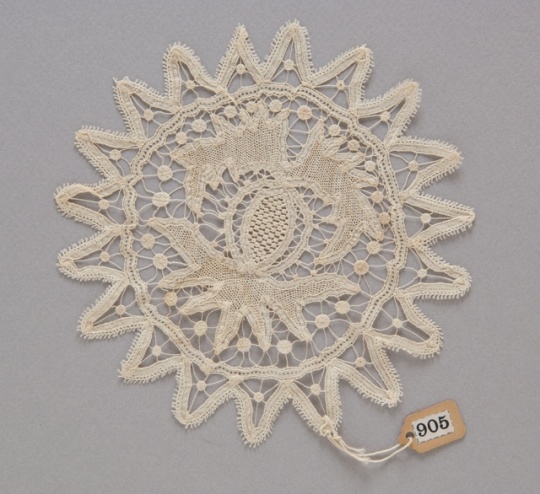
Dakota round lace doily
Lace doily made by Dakota women at Birch Coulee Mission, possibly as a result of the lace-making school, c.1890–1920.
All rights reserved
Holding Location
More Information
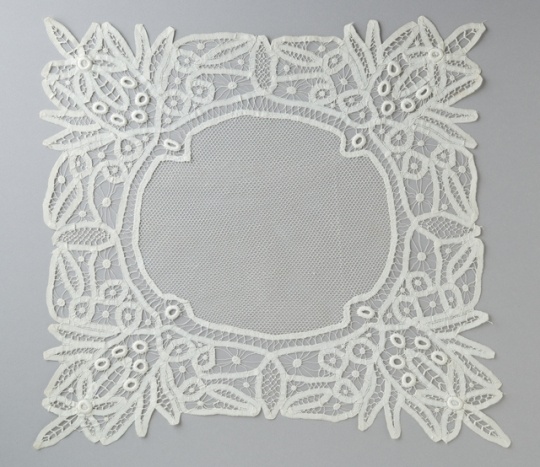
Battenberg lace table cover
Battenberg lace linen table cover. Circular net center with Battenberg lace edging. Tape work is joined with needle made spiders and eyelets with needle made buttonhole stitch and mesh fillings. Made by Dakota women at the Redwood Mission (Birch Coulee), Morton.
All rights reserved
Holding Location
More Information
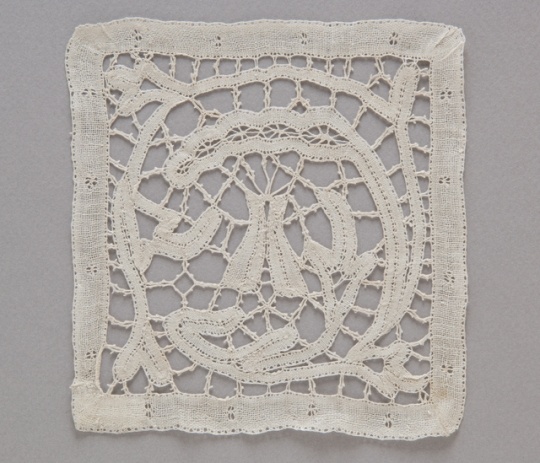
Bobbin lace doily with tipi motif
Tape lace linen doily; square with tape work in a tipi motif at center, joined by braids decorated with picots. Doily includes woven spider fillings and tape lace border.
All rights reserved
Holding Location
More Information
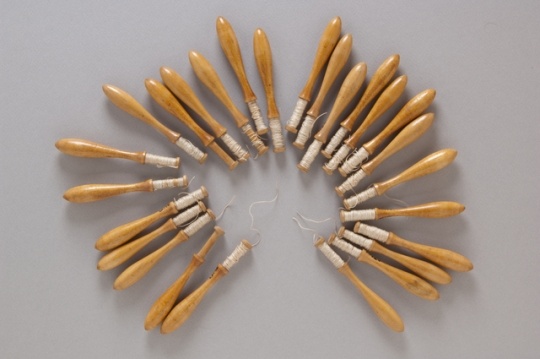
Lace bobbins
Set of twenty-six lace bobbins, used ca. 1890s–1910s. The Dakota women who made lace at the Redwood Mission (Birch Coulee) as part of Sybil Carter's Indian Lace Association used bobbins of this kind.
All rights reserved
Holding Location
More Information
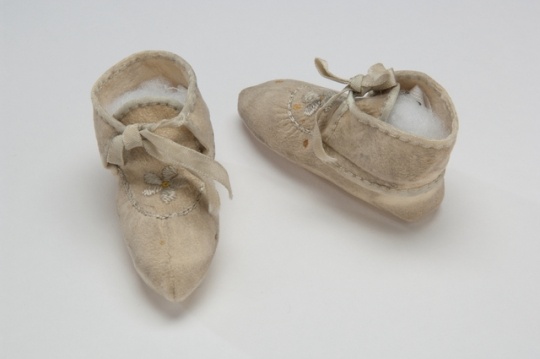
Dakota embroidered miniature moccasins
Miniature embroidered moccasins made at Birch Coulee and given to Evangeline Whipple by Julia Walker Lawrence in October of 1908.
All rights reserved
Holding Location
More Information
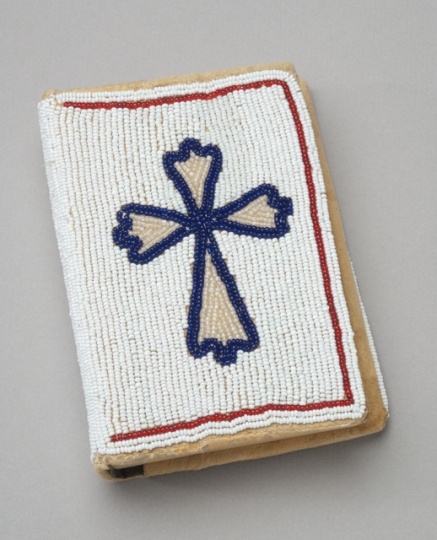
Beaded book cover
Beaded book cover made at Birch Coulee before 1936.
All rights reserved
More Information
Related Articles
Turning Point
Dakota women at Birch Coulee contact Sybil Carter, the organizer of a network of lace-making schools across the United States, in the early 1890s so that they can start a lace-making operation of their own. Over the next ten years, they earn a reputation for the quality and intricacy of their lace.
Chronology
1851
1862
1883
1893
1895
1900
1901
1903
1904
1904
1926
1938
Bibliography
Chase, Michelle C. “American Lace.” MA thesis, Winthrop University, 2004.
“Cleanliness and Work.” Semi-Weekly New Era (Lancaster, PA), March 21, 1900.
Duncan, Kate C. “American Indian Lace Making.” American Indian Art 5, no. 3 (Summer 1980): 28–35.
Dwyer, Mary. “Sybil Carter’s Legacy: Native American Lace.” PieceWork (November/December 1993): 66–71.
Guthrie, Jane W. “Lace-Making Among the Indians.” Outlook (September 1, 1900) 59–62.
Hutchinson, Elizabeth West. “Progressive Primitivism: Race, Gender and Turn-of-the-Century American Art.” PhD diss., Stanford University, 1998.
“Indian Lace Makers: A Dozen of Them Visit the Twin Cities.” St. Paul Daily Globe, October 4, 1895.
“Indian Lace Makers: Miss Sybil Carter’s Practical Work Among Indian Women.” Sunday Journal (Indianapolis, IN), October 14, 1900.
“Indian Lace Making.” St. Paul Globe, August 16, 1894.
“Indian Lace-Makers.” Evening Star (Washington, DC), February 28, 1903.
“Indian Women’s Needlework.” St. Paul Globe, December 20, 1903.
Lincoln, Louise, and Paulette Fairbanks Molin. “Unanswered Questions: Native Americans and Euro-Americans in Minnesota.” In Art and Life on the Upper Mississippi, 1890-1915, edited by Michael Conforti (Newark: University of Delaware Press), 299–322.
“Making Lace By Indian Women.” Boston Evening Transcript, March 21, 1896.
Snodgrass, Mary Ellen. Frontier Women and Their Art: A Chronological Encyclopedia. Lanham, MD: Rowman & Littlefield, 2018.
Sibyl Carter Indian Mission and Lace Industry Association annual report, 1905–1906.
https://archive.org/details/annualreport00sybi/page/6/mode/2up
Trump, Erik Krenzen. “The Indian Industries League and Its Support of American Indian Arts, 1893–1922: A Case Study of Changing Attitudes Toward Indian Women and Assimilationist Policy.” PhD diss., Boston University, 1996.
Related Resources
Secondary
Hyman, Collette. Dakota Women’s Work: Creativity, Culture, & Exile. St. Paul: Minnesota Historical Society Press, 2012.
Web
Lower Sioux Indian Community.
https://lowersioux.com
















